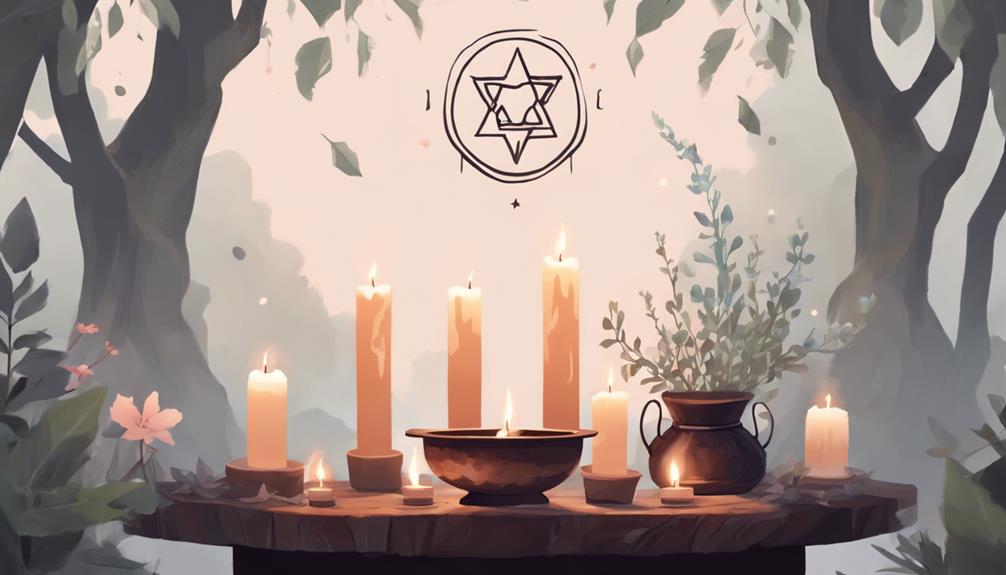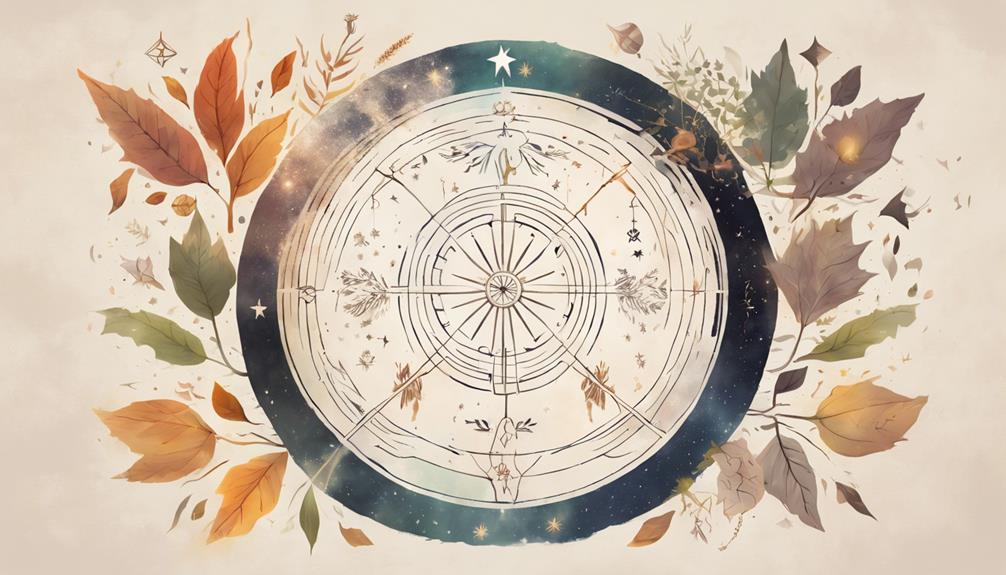Summary
- 1 Understanding Wicca
- 2 Fundamental beliefs
- 3 The Wiccan Rede
- 4 Tools of the Trade
- 5 Preparing your altar
- 6 Basic rites
- 7 Wheel of the Year
- 8 Moon phases
- 9 Elemental Magic
- 10 Starting your practice
- 11 Frequently asked questions
- 11.1 Can any person become a Wiccan, regardless of their background or previous beliefs?
- 11.2 How can I find a local Wiccan community or covens to join?
- 11.3 Are there any specific books or resources recommended for Wicca beginners?
- 11.4 What are some common misconceptions about Wicca that new practitioners should be aware of?
- 11.5 How can I practice Wicca discreetly if my living situation is not favorable?
To begin your journey in Wicca is to embrace nature and its rhythms. Begin by observing the cycles of the moon and the changes of the seasons. Create a sacred space with an altar, using items such as candles, an athame and a chalice. Practice simple rituals, such as lighting a candle with intention or taking mindful walks in nature. Follow the Wiccan Rede, which promotes actions that harm no one. Record your experiences in a Book of Shadows to track your progress. As you synchronize with nature and deepen your practices, you will find that there is much more to discover on your spiritual path.
Understanding Wicca

Wicca is a modern pagan religion, related to magic, which emphasizes a deep connection with nature and the cycles of the seasons. If you are new to Wicca, you may find its practices and rituals fascinating but mysterious. At its core, Wicca celebrates the Earth's natural rhythms. Imagine the changes of seasons: from the blooming flowers of spring to the cold, silent nights of winter. Wiccans honor these transformations through rituals, often performed during the key seasonal points called Sabbat.
You don't need a special place or sophisticated tools to get started. Nature is your temple. A simple walk in the woods, a quiet moment by a stream or even sitting in your own garden can be deeply spiritual. Pay attention to the world around you: the leaves rustling, the birds chirping, the warmth of the sun. These moments connect you to theessence of Wicca.
To begin, you may want to observe the phases of the moon. The moon has an important significance in Wicca, representing the changing aspects of the Goddess. Keep a small journal and write down your feelings and observations during the phases of the new, waxing, full and waning moon. This practice helps you to Synchronize with the cycles of nature And deepen your connection to Wicca.
Fundamental beliefs
At the heart of Wicca, you will find a'worship for nature and a belief in theinterconnectedness of all living things. Imagine walking through a forest and feeling a deep connection with the trees, animals and even the air around you. This sense of unity is a fundamental belief in Wicca. You will also discover that Wiccans honor the cycles of the moon and the changing seasons. These natural rhythms are seen as powerful forces that influence daily life.
Another key belief is the concept of duality. Wiccans often worship both a God and a Goddess, representing balance and harmony. Think of them as two sides of the same coin, both essential to the whole.
Magic, or 'magick' as it is often written in Wicca, is another vital element. It involves focusing energy and intention to bring about positive change. For example, you might perform a simple ritual to promote healing or protection.
Finally, Wiccans believe in the personal responsibility. Your actions have consequences, and it is important to live in a way that is respectful and aware of others and the world around you.
The Wiccan Rede

A guiding principle that binds all these beliefs together is the Wiccan Rede. The Wiccan Rede is often summarized by the phrase, 'An it harm none, do what ye will.' In simpler terms, it means that you can do what you will, as long as it harms no one, including yourself. This rule encourages you to think about the impact of your actions on others and the world around you.
Imagine planning a small ritual to bring more positivity into your life. According to the Wiccan Rede, you should make sure your actions do not cause harm. For example, using natural and nontoxic ingredients for your ritual respects the environment and aligns with the Rede.
The Wiccan Rede also promotes personal responsibility. You are encouraged to make ethical and thoughtful choices. If you wish to cast a spell for success, think about how it might affect others. Will it take something away from someone else's opportunity? If so, reconsider your approach to align with the Rede orientation.
Tools of the Trade
To practice Wicca effectively, you will need to become familiar with some essential tools of magical practice. These tools help focus your energy and intentions, making your rituals more powerful. Don't worry about getting them all at once; you can collect them over time.
Here is a simple table to get you started:
| Tool | Description | Use in Rituals |
|---|---|---|
| Athame | A ritual knife, often with a black handle | Directing energy, drawing circles |
| Wand | A stick or pole, usually made of wood | Channel for energy, invoke deities |
| Chalice | A cup or goblet | Containing liquids, symbolizing water |
| Pentacle | A record with a stave | Protection, channeling energy |
| Incense | Scented sticks or cones | Purifying space, invoking spirits |
For example, the athame is not for physically cutting but for directing energy. When you draw a circle, you will often use the athame to outline it in the air. The chalice, on the other hand, is used to represent the element of water and can hold wine or water during rituals.
Each tool has a unique role and enriches your connection to the elements. As you become more comfortable with these tools, they will feel like natural extensions of your magical practice. Enjoy your practice!
Preparing your altar

Setting up your altar is an exciting part of your Wiccan journey. It begins by gathering essential tools such as candles, crystals and a chalice, then find a quiet place where you will not be disturbed. Finally, make it personal Adding personal items that resonate with your spiritual path.
Essential tools for the altar
When setting up your altar, you will need some essential tools to create a sacred and functional space. Start with a altar napkin. It does not have to be fancy; any clean fabric will do. Next, you will need candles. They represent theelement of fire and can help create a magical atmosphere. Choose colors that resonate with your intentions.
You will also want a athame, a ritual knife, symbolizing your will and power. If you prefer, a wand can serve a similar function. For theelement of water, include a goblet or cup. You can fill it with water, wine or any liquid that you feel is meaningful to you.
Don't forget a census holders And some incense. This represents air and can help purify your space. A pentacle, often a disk engraved with a five-pointed star, represents the earth and acts as a protective symbol.
Finally, consider personal items such as crystals, herbs or small statues of the deities you feel connected to. These can enrich the energy of your altar. Remember, your altar is a reflection of you and your practice, so make it personal and meaningful. With these tools, you will be well on your way to creating a functional and sacred space.
Preparation of sacred space
Now that you have gathered your altar tools, let's talk about how to prepare your sacred space to set up your altar. Creating a sacred space means creating a special area that conveys calm and power. Here's how you can do it.
First, choose a quiet, private place where you will not be disturbed. This could be a corner of your bedroom or a small table in a secluded area. Clean the space thoroughly, removing any clutter or dust. This very act can be a form of meditation, helping you focus on the positive energy you are about to invite in.
Next, purify the area with sage or incense. Shake the smoke around the space, setting the intention to eliminate any negative energy.
When arranging your altar tools, place them carefully. Each object should have a special meaning and purpose.
Consider adding personal touches such as a fabric that resonates with you or fresh flowers.
Here is a checklist to guide you:
- Choose a quiet and private place
- Thoroughly clean the space
- Purify with sage or frankincense
- Carefully place your tools
- Add personal touches
Preparing your sacred space is the first step in creating a magical atmosphere for your Wiccan practice.
Customizing your altar
Personalizing your altar is where your creativity and spiritual connection truly come to life. It is a space that reflects your path and intentions. Start by choosing items that resonate with you. Common items include candles, crystals and statues of deities. However, there are no strict rules: your altar should feel like your sacred space.
Think about the meaning of each object. Candles can symbolize the element of fire and bring light to your rituals. Crystals such as amethyst or quartz can intensify energy. Statues or images of deities can serve as focal points for meditation or prayer. Here is a simple chart to help you decide what to include:
| Item | Symbolism | Examples of Use |
|---|---|---|
| Candles | Fire, light, intention | Rituals, meditation, spells |
| Crystals | Energy, healing | Amplify, focus energy |
| Statues of Deities | Divine connection | Meditation, worship |
| Incense | Air, purification | Purifying space, enriching concentration |
| Athame | Power, direction | Casting circles, rituals |
Arrange these objects in a natural way. There is no right or wrong way, only your own unique expression. Change your altar as needed. Seasonal objects or fresh flowers can keep it vibrant. Remember, your altar is a personal reflection of your spiritual path.
Basic rites
Now that your altar is set up, let's talk about how to perform basic rituals. You will begin with draw a circle, which creates a sacred space For your practice. Imagine it as drawing an invisible boundary that keeps positive energy in and distractions out.
Preparation of the Altar
To set up your altar, start by choosing a quiet, dedicated space where you can focus your energy and intentions. This space does not have to be large, but it should be free of distractions. Think of it as your sacred corner where you can connect with the divine.
Once you have chosen your place, gather some essential items to put on the altar. These items will help you channel your magical energy and clearly set your intentions:
- Candles: Representing the element of fire, candles bring warmth and light to your rituals.
- Crystals: Each type of crystal has its own unique energy. Choose the ones that resonate with your intentions.
- Chalice: This can be a simple cup or chalice. It symbolizes water and is often used in rituals to hold holy water or wine.
- Incense: Burning incense can purify your space and lift your spirit. Select scents that you find relaxing and inspiring.
- Wand or Athame: These tools help you direct energy and are often used in casting spells.
Basic principles of drawing a magic circle
Before performing any ritual, start the process with the creation of a protective circle is crucial in establishing a sacred space. This circle serves as the shield against negative energies And it helps to focus your intention. To get started, collect your tools: a wand or atame, salt, water, incense and a candle.
Initially, scatter salt around the designated ritual area, visualizing a circle taking shape as you proceed. Then, scatter water along the same path, symbolizing cleansing. Light incense and walk around the circle once again, imagining the smoke purifying the environment. Finally, light the candle and walks around the circle, imagining the light of the flame forming a protective boundary.
As you follow these steps, you can recite a simple magic formula as, 'I create this circle to protect and enclose, with radiant affection as our circle grows.' After creating the circle, you can continue with your ritual within this consecrated space.
At the end, it is essential to come full circle. Go through the circle counterclockwise, expressing gratitude to the elements and imagining the barrier dissipating. This ensures a safe return to your normal world, leaving sacred space behind.
Wheel of the Year

Have you ever wondered how Wiccans celebrate and honor the changes of the seasons? The Wheel of the Year is a central concept in Wicca, marking eight significant festivals known as Sabbats. These Sabbats align with natural events such as solstices, equinoxes and the midpoints between them. Celebrating these festivals helps you connect deeply with nature and its cycles.
Here is a quick overview of the eight Sabbats:
- Samhain: Often celebrated on October 31, it is a time to honor your ancestors and the cycle of life and death.
- Yule: Falling around December 21, this winter solstice festival celebrates the return of light as the days begin to lengthen.
- Imbolc: Celebrated on February 1 or 2, it marks the first signs of spring and is dedicated to Brigid, the goddess of fire and fertility.
- Beltane: On May 1, this festival is all about celebrating fertility, love and the flowering of life.
- Lughnasadh: Around August 1, this harvest festival honors the abundance of the earth and the beginning of the harvest season.
Moon phases
Understanding the phases of the moon is essential in Wicca, as each phase offers unique energies for different types of magical work. When you align your practices with the lunar cycle, you can harness these natural energies to enhance your spells and rituals.
Here is a simple guide to help you understand the different moon phases and the corresponding energies:
| Lunar Phase | Energy and Magical Work |
|---|---|
| New Moon | New beginnings, setting goals |
| Crescent Moon | Growth, attraction, abundance |
| First Quarter | Challenges, decisions, action |
| Crescent Gibbous Moon | Perfection, improvement, concentration |
| Full Moon | Power, completion, clarity |
During the New Moon, focus on setting new intentions or starting fresh projects. As the Moon grows, so does the energy to attract what you desire, making the Crescent Moon ideal for manifesting abundance. The First Quarter is a time to take action and overcome obstacles.
When the Moon is Gibbous Crescent, refine your plans and focus on what needs improvement. The Full Moon is a powerful phase for bringing things to fruition and gaining clarity, perfect for high-energy rituals and magical work.
Elemental Magic

Elemental magic draws on the natural energies of earth, air, fire and water to enhance your spells and rituals. Each element has unique properties and strengths that you can harness. Earth represents stability and growth. Air symbolizes intellect and communication. Fire stands for transformation and passion. Water stands for emotion and healing.
To connect with these elements, start by observing them in your daily life. Feel the earth beneath your feet, the breeze on your face, the warmth of a candle flame, and the soothing flow of water. You don't need sophisticated tools, just a sense of awareness and respect for nature's gifts.
Here is how to summon the power of each element:
- Earth: Meditate in a garden or park, bury a small crystal in the ground.
- Air: Write your intentions on paper and let the wind carry them away.
- Fire: Light a candle with a focused mind, imagining your desires being lit.
- Water: Take a ritual bath, visualizing negativity flowing away.
- Spirit: Combine all elements in a simple ritual to feel a deeper connection with the universe.
Starting your practice
Now that you are familiar with the magic of the elements, it is time to take the first steps to begin your Wiccan practice. Start by creating a sacred space. This could be a small altar On a shelf or in a corner of your room where you feel calm and focused. Adorn it with objects that resonate with you: candles, crystals or symbols of the elements.
Next, learn how to root yourself. Rooting yourself helps you connect with the earth and stay balanced. A simple technique is to sit quietly, visualize roots growing from your feet into the ground and do deep breaths, feeling the energy of the earth flowing into you.
Daily rituals can help you build your practice. Light a candle each morning and set an intention for the day. It can be simply hoping for patience or creativity.
Finally, keep a Book of Shadows. It is a personal journal where you can record your experiences, spells and understandings. Over time, you will see your growth and learn what works best for you.
Frequently asked questions
Can any person become a Wiccan, regardless of their background or previous beliefs?
Absolutely, anyone can become a Wiccan. It doesn't matter what your background or previous beliefs are. Wicca is open to anyone who feels a connection to its practices, nature and spirituality. Just start investigating!
How can I find a local Wiccan community or covens to join?
To find a local Wiccan community or group, start by checking online forums, social media groups, or local metaphysical stores. Attend events such as pagan festivals or workshops to meet people with similar interests and gather information.
Are there any specific books or resources recommended for Wicca beginners?
Start with Scott Cunningham's 'Wicca: A Guide for the Solo Practitioner' and Starhawk's 'The Spiral Dance.' These are easy reads and offer valuable perspectives. Don't forget to check local libraries and online forums for additional resources.
What are some common misconceptions about Wicca that new practitioners should be aware of?
You might think that Wicca involves black magic or devil worship, but it does not. It is about nature, balance and positive energy. Many people also mistakenly believe that Wiccans can cast spells instantly, but it takes practice and concentration.
How can I practice Wicca discreetly if my living situation is not favorable?
If you need to practice Wicca discreetly, try using digital tools for rituals, keep your altar small and portable, and incorporate everyday objects into your practice. Meditation and visualization can also be done in silence.
